

A new century beckons
by Tony Wrenn, Hon. AIA
AIA President Leon Chatelain Jr., a Washingtonian, presided over
the AIA during its Centennial Year in 1957, with a clear message to
the membership: “All that the architects of America have come
to know in the hundred years since 1857, all of the ingredients and
technology and craft that is architecture in 1957, can barely
answer the need of our times. Of the future we know only this: that
its pressures and the sum of the daily hungers of its people will
pull us into a frenzy of coordinated creativity. The hundred years
that have crowded in behind us have pushed us into another century
of professional evolution. We have neither time nor balance to
stand still, to contemplate our past. In the year of our
centennial, let us look with care where we are going—into the
future. We are needed there.”
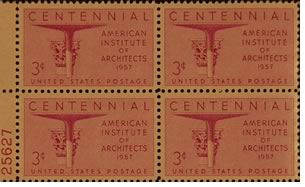 The centennial
celebration began in New York City, the AIA’s birthplace, with
unveiling of a plaque at 111 Broadway, the site of the first AIA
meeting. Simultaneously, the U.S. Postal officials issued a
commemorative stamp marking the centennial. Featuring a classical
column with a superimposed Wrightian column, it cost just 3 cents
and was heavily used by the Institute and members.
The centennial
celebration began in New York City, the AIA’s birthplace, with
unveiling of a plaque at 111 Broadway, the site of the first AIA
meeting. Simultaneously, the U.S. Postal officials issued a
commemorative stamp marking the centennial. Featuring a classical
column with a superimposed Wrightian column, it cost just 3 cents
and was heavily used by the Institute and members.
The centennial convention, held May 13–17 in Washington, D.C.,
played like a great pipe organ with all stops out. Agnes E. Meyer,
David Finley, Paul Tillich, Bennett Cerf, Howard Mitchell, Leo
Friedlander, Henry F. Luce, Walter P. Reuther, and Lilian Gish were
speakers and participants. Gish argued for architects signing their
buildings, and blamed the architects for the public’s lack of
knowledge of what architects produced. “You remind me of my
own family, who believe a lady should have her name in the public
print just three times—when she is born, when she is married
and when she dies. In my lifetime I have heard of only two
architects: Frank Lloyd Wright, God bless him for what he has done
to make even the word ‘Architecture’ known to us; and the
other is a memory of my childhood, Stanford White who got shot.
(Laughter) A prize fighter gets more publicity and in some
instances a truck driver is better paid. It would seem that our
system of values has reached an Alice in Wonderland absurdity,
worthy only of satire.”
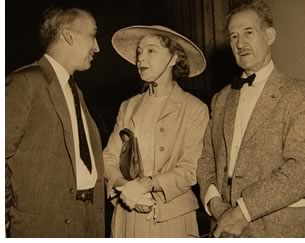 Sculptor
Sidney Waugh designed a bronze Centennial Medal, for convention
attendees. One medal was cast in Gold and presented to President
Eisenhower, who “was very gracious and received this in his
private chambers after which he appeared before the
reporters.” Film of the presentation was shown at the
convention and a message from Eisenhower was read: “From the
earliest days of our Republic the profession of architecture has
contributed to the growing industry of our land, to the development
of our public buildings and to raising in form and fabric the
aspirations of our people.”
Sculptor
Sidney Waugh designed a bronze Centennial Medal, for convention
attendees. One medal was cast in Gold and presented to President
Eisenhower, who “was very gracious and received this in his
private chambers after which he appeared before the
reporters.” Film of the presentation was shown at the
convention and a message from Eisenhower was read: “From the
earliest days of our Republic the profession of architecture has
contributed to the growing industry of our land, to the development
of our public buildings and to raising in form and fabric the
aspirations of our people.”
Recording the past—in 90 days
Henry H. Saylor, Fellow of the Institute and longtime
editor of its Journal “recognized the anomaly of
celebrating a history that had never been recorded. Although the
emphasis of the celebration was rightly put on the future rather
than the past—a new century beckons—it seemed advisable
to make at least a gesture toward the road over which we have
traveled,” and Saylor did something which perhaps no other
member could have done.
“With but ninety days available for the reading of one hundred
years of proceedings, minutes, documents, and doing the supporting
research, the writing of a definitive history of the
Institute’s first hundred years was out of the
question....This hasty sketch is the alternative....Perhaps,
however, with a frank admission of its shortcomings, this little
volume will give an occasional glimpse, as through a glass darkly,
of the way The Institute has come to a maturity which enables us to
look with confidence to the century that beckons,” Saylor
wrote. He penned that preface in March, and his The
A.I.A.’s First Hundred Years, was published as the May
issue of the AIA Journal, ready to be rebound as a book
for all who desired. It has served the Institute well, with its
topical presentation, a time line and a useful index.
Celebratory activities abound
The National Gallery of Arts’ “One Hundred Years
of Architecture in America” exhibition and accompanying
catalog prepared by Fritz Gutheim featured, in addition to
buildings from the Institute’s century, a listing of 10
contemporary buildings that would influence America’s future.
The organizers were not above doctoring photographs to make a
point. The Connecticut Life Insurance Company Building appeared in
a dramatic photograph across a snowy field with a fence in the
foreground. It had everything but scale, which they provided by
placing a cutout of a hunter with rifle in the foreground
The AIA awarded two Gold Medals during the Centennial celebration.
One went to Louis Skidmore with a citation that noted that previous
medals had been given largely upon individual service, while
“you have built an organization with the name of Skidmore,
Owings & Merrill.” The other Gold Medal, labeled the
“Centennial Gold Medal of Honor,” was given to Ralph
Walker, essentially for service to the profession, a reason for
recognition as different as was that of Skidmore. Walker would not
disappoint, even in his acceptance. He insisted that America’s
cities and her environment were the AIA’s responsibility and
must be protected and preserved. Indeed, if one follows the trail
of words before Institute boards, committees, and chapters that
Walker left us, it is clear that for years he had been the
AIA’s guide and conscience.
A capital win, a Capitol loss
One action in the AIA’s centennial year seemed out of
place: the Institute’s Douglas Orr, former AIA president and
member of the President’s Advisory Commission on Presidential
Office Space, argued in an article on “New Offices for the
White House,” which appeared in the December 1957
Journal, for the advantages of replacing the Alfred B.
Mullett’s 1888 State, War and Navy Building (the former OEOB,
or Old Executive Office Building, today known as the Eisenhower
Building) and noted that “because the White House has been one
of the prime concerns of the Institute, whatever develops in
providing the President with adequate quarters is of great
import.”
A giant French Second Empire pile, the building may have had few
vocal friends, but that would change quickly. It has been said that
President Eisenhower’s horror at the cost of demolishing the
vast stone and iron building actually saved it, but assessments of
the building’s architectural value also played a part. The
Journal carried in its May 1959 issue, an article titled
“Architecture Worth Saving,” which included, with
illustration, the State, War and Navy Building. It today serves the
purpose Orr and his committee envisioned for the site, but through
retrofitting, not through demolition and new construction.
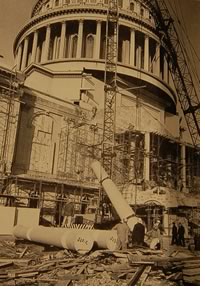 Across the
city, the extension of the East Front of the Capitol loomed close
to becoming a reality in 1958, as the Congress refused to budge.
The AIA Board asked the convention to reaffirm its opposition.
Ralph Walker again emerged as a powerful spokesperson, writing
about it in the January and June 1958 Journals and
speaking at convention. Although AIA members were involved in the
proposed work to extend the East Front, Walker believed “there
are times when the Institute has to take the position, in regard to
the public welfare, that it is bigger than any of its members;
otherwise, it, The Institute, will degenerate into a trade
association having no other ambition than that of merely obtaining
jobs for its members.” Marcellus Wright labeled the extension
a “disastrous move to toy with the East Front of our National
Capitol.”
Across the
city, the extension of the East Front of the Capitol loomed close
to becoming a reality in 1958, as the Congress refused to budge.
The AIA Board asked the convention to reaffirm its opposition.
Ralph Walker again emerged as a powerful spokesperson, writing
about it in the January and June 1958 Journals and
speaking at convention. Although AIA members were involved in the
proposed work to extend the East Front, Walker believed “there
are times when the Institute has to take the position, in regard to
the public welfare, that it is bigger than any of its members;
otherwise, it, The Institute, will degenerate into a trade
association having no other ambition than that of merely obtaining
jobs for its members.” Marcellus Wright labeled the extension
a “disastrous move to toy with the East Front of our National
Capitol.”
The Convention resolution, publicized widely and made known to the
members of Congress, did not carry the necessary weight, and work
on the “much debated project commenced. The new front is
scheduled for completion in time for the 1960 inauguration.”
The Journal reported in its April 1959 issue that the
“columns from the portico lay wearily on the ground...Sad
sight.”
Fighting “urban removal”
The 1961 Board noted the growing importance of The
Octagon, the AIA’ s “Embassy in Washington,” where
visitors from around the world came to see and talk about
architecture, and applauded President John Fitzgerald
Kennedy’s new view of Lafayette Square across Pennsylvania
Avenue from the White House. The AIA Committee on the National
Capital was involved and “after reviewing proposals for the
development...the committee issued a statement expressing its
confidence ‘that through skillful design,' Lafayette Square
can become an area of great architectural importance to future
generations...The committee believes it is quite possible to
restore the integrity of the square from its present cluttered
appearance. Carefully designed new buildings framing the park can
complement the White House rather than overwhelm it if kept in
proper scale.”
Prior plans had called for demolition of everything on the Jackson
Place side of the Square, except Blair House, the President’s
Guest House, and Decatur House, a property of the National Trust
for Historic Preservation. On the Madison Place side, nothing would
be saved. The new plan called for the retention of historic
buildings on both sides of the square, new buildings of like scale
as fill around the Park’s perimeter, and the construction of
tall buildings in the center of the blocks.
That plan would change architecture in the inner city. Facades
would be saved (even when whole buildings could not be), and infill
buildings would be compatible in scale and materials with the
existing historic material. Contemporary buildings in historic
settings became the norm. The positive effects of this—in
preservation, beauty, urban scale, and development costs—were
substantial. Simultaneous planning of the AIA’s new
headquarters buttressed the Lafayette Square plan; even as the
Institute reorganized its staff and goals, it planned for “a
new headquarters to serve as a national center for the advancement
of the environment arts and sciences.”
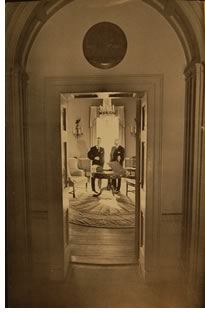 Growing
interest in urbanism
Growing
interest in urbanism
President Kennedy sent greetings to the 1961 convention,
recognizing that ”your role and work in urban renewal is a
major one, and I am glad to send you personal greetings for your
convention and its timely theme of redesigning urban America. Your
current influence and work can reshape the urban life of this
country, and is a challenge that no other generation of architects
has yet had. I deeply appreciate your support on the Housing Bill
and the Department of Urban Affairs legislation.”
Discussion of the new AIA headquarters building, “adequate to
the growing needs of the Institute and worthy of the importance and
dignity of the architectural profession,” continued in 1962.
Still, its larger setting was of concern as the AIA Board and its
Committee on the National Capitol deplored “ the way the
visual appearance of streets and avenues is being spoiled by
cutting down of trees, narrowing of sidewalks, etc., and on such
places as the Mall and other park areas by the thousands of parked
cars. It notes that this generation has a responsibility to
preserve the parks, malls and open spaces that are our heritage and
they must not be frittered away to accommodate traffic or
commercial uses.”
The concern included support of the “Fine Arts Commission...in
urging that further construction on the proposed inner loop be
stopped, believing that a comprehensive and effective mass transit
program, now under study, may well eliminate the need for big
highways into and around the downtown area.” It was too late
in some cases, and major highways passed beneath the Mall and
surfaced within sight of the Capitol’s west front, and crossed
the Potomac over Theodore Roosevelt Island, in sight of the Lincoln
Memorial, chiseling away at the relationship of Edward Durrell
Stone’s National Cultural Center [now the Kennedy Center] to
the city. Interstate 66 was finally interrupted there however, and
its open gash across the Mall in front of the Lincoln Memorial
never materialized.
 Honoring
Kennedy
Honoring
Kennedy
The 1963 Board “cited with honor John Fitzgerald
Kennedy, President of the United States, in a unanimous resolution,
which comes within no established award and is given for the first
time.” When AIA President J. Roy Carroll Jr. presented Kennedy
with the award at the White House on May 22, he said, “But
you, sir, are the first President of the United States—except
possibly the first and third ones—who has had a vision of what
architecture and its allied arts can mean to the people of the
nation, and of what the careful nurturing of the architecture of
the city of Washington can mean to those millions who come here to
pay homage to the heart of their country.”
In the same year, AIA President Henry L. Wright lauded the AIA for
its difference from other professional and trade associations.
“It is actually operated under the direction of the
members....The forty-five committees, and 350 architects, members
who serve on them, are working committees.” He took
note of the aging population and its increased leisure time.
“Our plans for the future must consider the leisure
time of tomorrow’s citizen. If our urban design encompasses
thoughts for recreation facilities, for increased learning of all
things, at all ages, and if our plans include facilities for the
development and expression of the arts as well as the sciences, our
civilization may experience a renaissance of culture beyond our
most fervent hopes.”
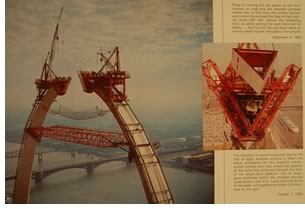 Meeting in St.
Louis in 1964, members watched and marveled at the construction of
Eero Saarinen’s Gateway Arch. It served as the symbol for that
year’s convention and its theme: “The City—Visible
and Invisible.”
Meeting in St.
Louis in 1964, members watched and marveled at the construction of
Eero Saarinen’s Gateway Arch. It served as the symbol for that
year’s convention and its theme: “The City—Visible
and Invisible.”
Toward a new headquarters
Work toward construction of the new National Headquarters Building
behind the Octagon began with a competition brochure issued on
January 22, 1964 that established the rules, not just for the AIA
building, but, it could be argued, for future contemporary
buildings in historic settings. “The object of the competition
is the creation of a design for a new National Headquarters
Building that will satisfy both physical and spiritual
functions—a building of special architectural significance,
establishing a symbol of the creative genius of our time yet
complimenting, protecting and preserving a cherished symbol of
another time, the historic Octagon House,” it said. In
suggesting the “Character of Building” the announcement
was specific: “The character of the new building must not only
be compatible with the Octagon, it must preserve, compliment and
enhance the historic residence. However, this should not be
interpreted as suggesting the copying of the form or detailing of
William Thornton’s design, nor any stylistic re-creation of
colonial architecture. What is wanted is a more thoughtful, more
sensitive and more meaningful solution; an exciting demonstration
that fresh and contemporary architecture can live in harmony with
fine architecture of another period; each statement giving the
other more meaning and contributing to the delight of the entire
building complex.”
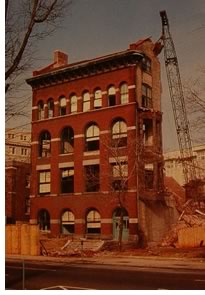 Registration
for the competition ended on March 15, 1964 with 625 registrants,
221 of whom actually submitted entries. Seven first stage winners,
selected on May 18, were asked to prepare final drawings. The final
stage ended on October 1, and on November 2 the competition winner,
the firm of Mitchell/Giurgola, was announced. “The winning
design envisages a five-story, red-brick structure featuring a
semi-circular glazed wall which will embrace the gardens and
Octagon House. It will enclose about 50,000 square feet of usable
floor space and its estimated cost is $1,450,000. An additional
$30,000 has been allocated for sculpture or other fine
arts....tentative plans indicate working drawings should be
completed by March 1966. The Octagon House, which will be closed
during the construction period, will also undergo some
renovation.”
Registration
for the competition ended on March 15, 1964 with 625 registrants,
221 of whom actually submitted entries. Seven first stage winners,
selected on May 18, were asked to prepare final drawings. The final
stage ended on October 1, and on November 2 the competition winner,
the firm of Mitchell/Giurgola, was announced. “The winning
design envisages a five-story, red-brick structure featuring a
semi-circular glazed wall which will embrace the gardens and
Octagon House. It will enclose about 50,000 square feet of usable
floor space and its estimated cost is $1,450,000. An additional
$30,000 has been allocated for sculpture or other fine
arts....tentative plans indicate working drawings should be
completed by March 1966. The Octagon House, which will be closed
during the construction period, will also undergo some
renovation.”
The new building was driving the AIA. Institute President Morris
Ketchum told the convention in Denver in late June 1966: “The
total objective will be to create on an enlarged site a new
headquarters building adequate for our growth, a complete
restoration of The Octagon as a beautiful landmark of our
architectural heritage and a garden which states our principles of
open space and contribute to the scale and harmony of the two
buildings. In short, the design of the entire complex must
exemplify what our profession urges our clients to do.”
It would not be an easy task.
Copyright 2005 The American Institute of Architects. All rights reserved. Home Page

